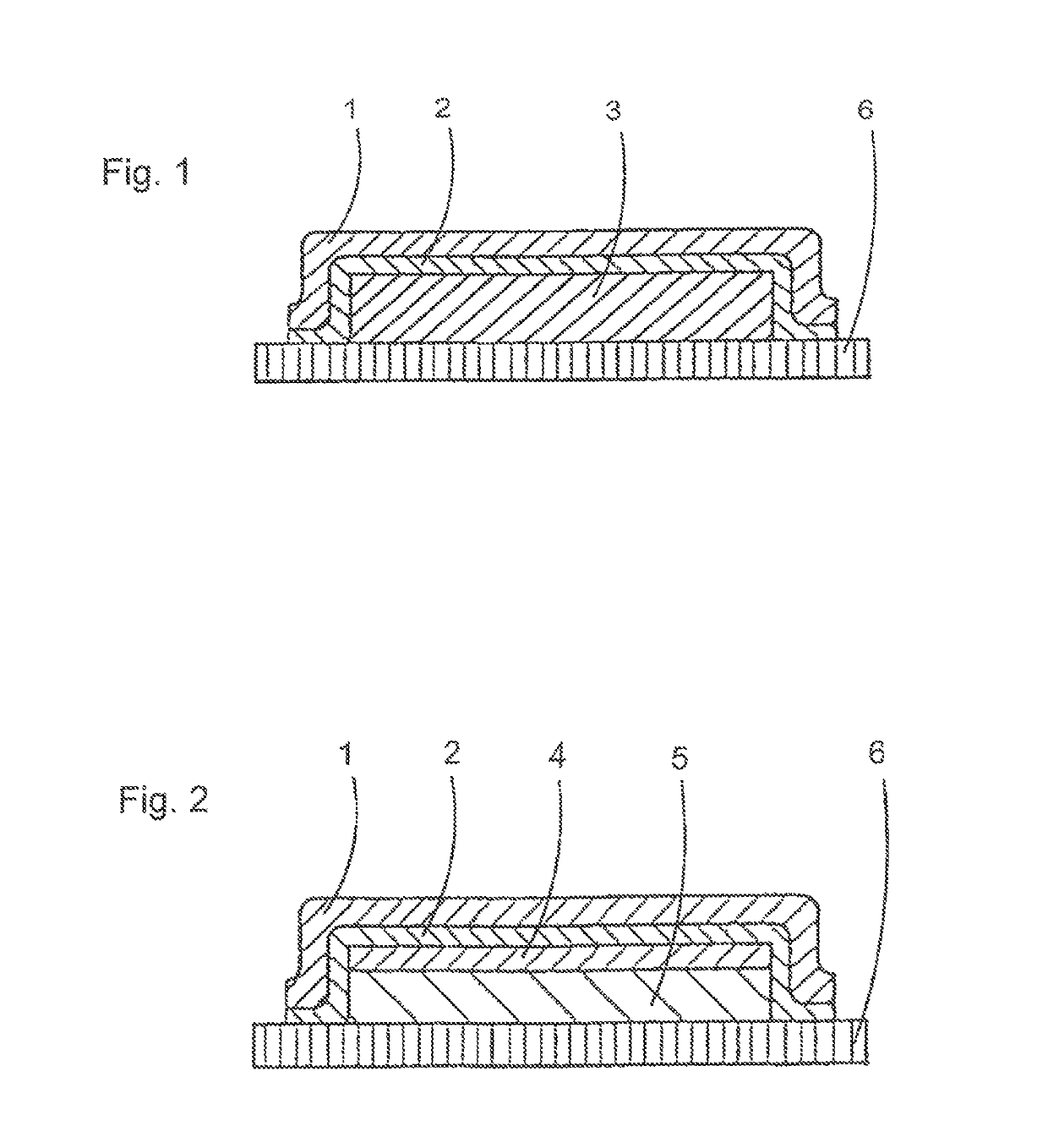Over-patch having improved compatibility and a long adhesion duration and method for producing said over-patch
a technology of over-patch and compatibility, applied in the field of medical products, can solve the problems of inability to reliably diagnose the diagnosis agent, slippage of the cannula, and still no medical products which address this issue, and achieve the effects of improving skin compatibility, reducing the occlusion effect, and improving water vapor permeability
- Summary
- Abstract
- Description
- Claims
- Application Information
AI Technical Summary
Benefits of technology
Problems solved by technology
Method used
Image
Examples
examples 1-5a (
DoE1) with Polyacrylate Adhesive+Neutral Oil:
Preparation of the Composition for the Active-Ingredient-Free Overplaster with Polyacrylate Adhesive Neutral Oil:
[0087]A vinyl acetate-acrylate copolymer solution in ethyl acetate / ethanol / heptane with a solids fraction of 40-43% [w / w] is admixed with a solution of neutral oil (Miglyol) , and the total solids fraction of the solution is adjusted with ethanol to 40%.
[0088]Stirring then takes place until the solution is homogeneous.
[0089]This adhesive solution (composition) is utilized for producing the active-ingredient-free, skin-facing side (layer 2) of the overplaster.
Coating and Drying the Composition on Intermediate Carriers:
[0090]The composition is coated onto a siliconized PE paper in such a way that, following evaporation of the solvents in a drying cabinet or drying tunnel at not more than 100° C., a layer of adhesive is formed which has a basis weight of 50-100 g / m2.
[0091]The compositions of the adhesive solutions used for the ove...
examples 6-10 (
DoE2) with Polyacrylate Adhesive Dexpanthenol:
Preparation of the Composition for the Active-Ingredient Free Overplaster with Polyacrylate Adhesive+Dexpanthenol:
[0093]A vinyl acetate-acrylate copolymer solution in ethyl acetate / ethanol / heptane with a solids fraction of 40-43% [w / w] is admixed with dexpanthenol, and the total solids fraction of the solid is adjusted with ethanol to 40%.
[0094]Stirring then takes place until the solution is homogeneous.
[0095]This adhesive solution (composition) is utilized for producing the active-ingredient-free, skin-facing side (layer 2) of the overplaster.
Coating and Drying the Composition on Intermediate Carriers:
[0096]The composition is coated onto a siliconized PE paper in such a way that, following evaporation of the solvents in a drying cabinet or drying tunnel at not more than 100° C., a layer of adhesive is formed which has a basis weight of 50-110 g / m2.
[0097]The compositions of the adhesive solutions used for the overplaster per formulation ...
examples 11-15 (
DoE3) and 16-20 (DoE4) with Non-Amine-Resistant Polysiloxane Adhesive+Silicone Oil:
Preparation of the Composition for the Active-Ingredient-Free Overplaster with Non-Amine-Resistant Polysiloxane Adhesive+Silicone Oil:
[0099]A non-amine-resistant polysiloxane adhesive solution in heptane (alternatively ethyl acetate) with a solids content of 50-70% [w / w] is admixed with silicone oil, optionally diluted to 60-70% with n-heptane (or with ethyl acetate in the case of non-amine-resistant polysiloxane adhesives in solution in ethyl acetate), and then stirred until a homogeneous solution is formed. This adhesive solution (composition) is utilized for producing the active-ingredient-free, skin-facing side (layer 2) of the overplaster.
Coating and Drying the Composition on Intermediate Carriers:
[0100]The composition is to a fluoropolymer-coated PET film (protective layer and / or intermediate carrier) in such a way that, after evaporation of the solvents in a drying cabinet or drying tunnel at n...
PUM
| Property | Measurement | Unit |
|---|---|---|
| wear time | aaaaa | aaaaa |
| size | aaaaa | aaaaa |
| thickness | aaaaa | aaaaa |
Abstract
Description
Claims
Application Information
 Login to View More
Login to View More - R&D
- Intellectual Property
- Life Sciences
- Materials
- Tech Scout
- Unparalleled Data Quality
- Higher Quality Content
- 60% Fewer Hallucinations
Browse by: Latest US Patents, China's latest patents, Technical Efficacy Thesaurus, Application Domain, Technology Topic, Popular Technical Reports.
© 2025 PatSnap. All rights reserved.Legal|Privacy policy|Modern Slavery Act Transparency Statement|Sitemap|About US| Contact US: help@patsnap.com

